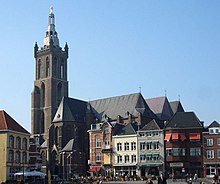Roman Catholic Diocese of Roermond
Diocese of Roermond Dioecesis Ruremundensis Bisdom Roermond | |
|---|---|
 Saint Christopher Cathedral | |
 Coat of arms | |
| Location | |
| Country | |
| Territory | Limburg |
| Metropolitan | Archdiocese of Utrecht |
| Statistics | |
| Area | 2,209 km2 (853 sq mi) |
| Population - Total - Catholics | (as of 2020) 1,131,930 1,086,540 (96%) |
| Information | |
| Denomination | Catholic |
| Sui iuris church | Latin Church |
| Rite | Roman Rite |
| Established | 12 May 1559 (re-established 4 March 1853) |
| Cathedral | Cathedral of Saint Christopher in Roermond |
| Current leadership | |
| Pope | Francis |
| Bishop | Sede vacante |
| Metropolitan Archbishop | Wim Eijk |
| Auxiliary Bishops | Everard de Jong |
| Bishops emeritus | Frans Wiertz |
| Map | |
 Location of the Diocese of Roermond | |
| Website | |
| bisdom-roermond.nl | |
The Diocese of Roermond (Latin: Dioecesis Ruremundensis) is a diocese of the Latin Church of the Catholic Church, located in the Netherlands. The diocese is one of the seven suffragan dioceses in the ecclesiastical province of the Metropolitan Archbishop of Utrecht. The territory of the diocese covers the Province of Limburg.
Its cathedral episcopal see is the Cathedral of St. Christopher in Roermond.
Its main pilgrimage sites are Kapel in 't Zand and Valkenburg.
The Dean of Roermond is responsible for the parishes in that city and a few other municipalities in the diocese.
History[edit]

Originally established on 12 May 1559, on territories split off from the Metropolitan Archdiocese of Cologne (Keulen, now in Germany) and Diocese of Liège (Luik, now in Belgium).
During the Napoleonic era, on 1801.07.15 it lost territory to establish the Apostolic Vicariate of Grave–Nijmegen, on 1801.11.29 the diocese was suppressed, its territory being divided between the above vicariate and to establish the (German) Diocese of Aachen (Aix-la-Chapelle).
It was re-established in 1840 by the Holy See as (pre-diocesan) Apostolic Vicariate of Limburg. In 1853 it was promoted as Diocese of Roermond and gained territory from the Belgian Diocese of Liège.
During the sixties of the twentieth century, the relatively strong demarcation between the Catholic south on one side and the Calvinist west and north on the other side of the Netherlands started to diminish. In the second half of the twentieth century a rapid secularization and strong loss of religious affiliation have taken place in Limburg.
Statistics and population[edit]
The diocese has roughly 817,000 registered Roman Catholics (about 72.3% of the population of Limburg). Roughly 3 percent of the population in the Diocese Roermond attends Mass on Sundays[1] (as per official Church (KASKI) data). The Roermond diocese is one of the two in the Netherlands that is in a majority-Catholic region, as per the most recent KASKI data.
As per 2014, it pastorally served 1,091,000 Catholics (96.0% of 1,136,000 total) on 2,209 km² in 303 parishes with 471 priests (219 diocesan, 252 religious), 71 deacons, 1,210 lay religious (440 brothers, 770 sisters) and 24 seminarians.
Limburg is mostly Roman Catholic by tradition and still uses the term and certain traditions as a base for its cultural identity, though the vast majority of the population is now largely irreligious in practice. Research among Dutch Catholics in 2006 shows that only 27% of the Dutch Catholics can be regarded as a theist, 55% as an ietsist / agnostic theist and 17% as agnostic.[2]
Episcopal Ordinaries[edit]
- Suffragan Bishops
- Willem Damasus Van der Lindt (1562–1588)
- Hendrik van Cuyk (1596–1609)
- Jacobus a Castro (1611–1639)
- Andreas Creusen (1651–1657)
- Eugène, Count d'Allamont (1659–1666)
- Lancelot de Gottignies (1670–1673)
- Reginald Cools, O.P. (1677–1700)
- Angèle, Count d'Ongnies et d'Estrees, O.F.M. Cap. (1701–1722)
- François-Louis Sanguessa, O.F.M. (1722–1741)
- Jan-Baptist de Castillion (1742–1743)
- Joseph Anselme François Werbrouck (1743–1746)
- Jean-Antoine de Robiano (1746–1769)
- Jan Hendrik van Kerens, S.J. (1770–1775)
- Philippus, Empire Count van en tot Hoensbroeck (1775–1793)
- Jan, Baron van Velde tot Melroy en Sart-Bomal (1794–1801)
- Apostolic Vicar of Limburg
- Joannes Augustus Paredis (1840.12.18 – 1853.03.04 see below), Titular Bishop of Hirina (1840.12.18 – 1853.03.04)
- Suffragan Bishops
- Jan Augustus Paredis (see above 1853.03.04 – death 1886.06.18)
- Frans Boermans (1886–1900)
- Jozesh Hubertus Drehmans (1900–1913)
- Lorenz Schrijnen (1914–1932)
- Jozef Hubertus Willem Lemmens (1932–1958)
- Jan Michiel Jozef Antoon Hanssen (1958-1958)
- Pieter Jan Antoon Moors (1959–1970)
- Jan Baptist Matthijs Gijsen (1972–1993)
- Alphons Castermans, auxiliary (1982–1997)
- Frans Jozef Maria Wiertz (1993–2017)
- Everard de Jong, auxiliary (1999–)
- Harrie Smeets (2018–2023)
See also[edit]
References[edit]
- ^ Rapportnr. 590 Kerncijfers 2008 uit de kerkelijke statistiek van het Rooms-Katholiek Kerkgenootschap in Nederland door drs. Joris Kregting en Jolanda Massaar-Remmerswaal, augustus 2009
- ^ God in the Netherlands' (1996-2006), by Ronald Meester, G. Dekker, ISBN 9789025957407
External links[edit]
- GCatholic.org - data for all sections
- Website of the diocese of Roermond
- Roermond - Catholic Encyclopedia article
- Wikipedia page in Dutch about the cathedral

